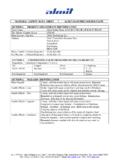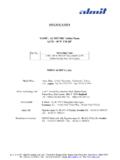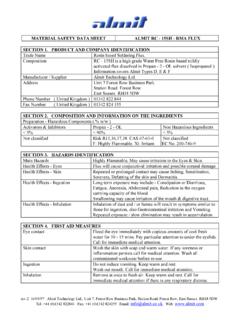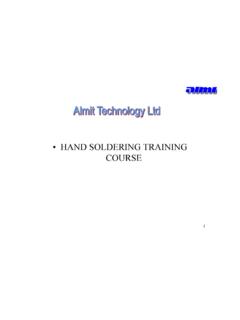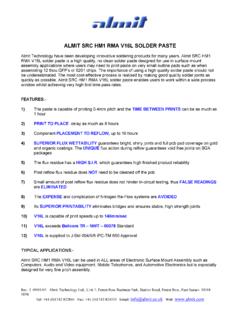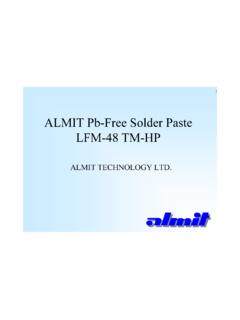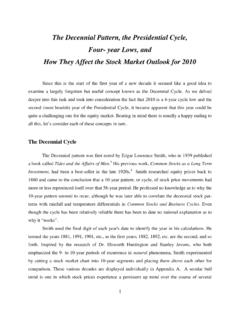Transcription of Difference Between Various Sn/Ag/Cu Solder …
1 Difference Between Various Difference Between Various Sn/Ag/Cu Solder CompositionsSn/Ag/Cu Solder CompositionsAlmit Sawamura Takeo Igarashi29/6/2005 Table Of ContentsTable Of Contents1. Overview2. Mechanical Properties3. Reliability Results4. ConclusionAbout Nihon Almit Co., Ltd. Founded: 1956 Leading manufacturer in Japan for Solder products. First manufacturer in the world to produce aluminum Solder . SnPb products adopted and used by NASA for space shuttle project. Customers: Automotive: Honda / Hyundai / Mitsubishi / Nissan / Toyota / Volvo Non-Automotive: Ericsson / Hitachi / LG / NEC / Panasonic / Philips / Pioneer / Samsung / Sanyo / Sharp / Siemens / Sony OverviewThe use of lead is being banned to help preserve the environment, and the traditionally used Sn-Pb Solder is being restricted (RoHS etc.)
2 From reliability standpoints, Sn/Ag/Cu alloys has been chosen as the replacement for Sn-Pb Solder . However, there is no industry standard on which alloy to chose among the Various Sn/Ag/Cu alloys available in the market. - Sn + Ag + Cu (iNEMI recommended)- Sn + Ag + Cu - Sn + Ag + Cu (JEITA recommended)Purpose of this test- To determine the Difference in performance and reliability among the Various Sn/Ag/Cu alloys, and find out which alloy will be best suited for Various applications, especially under harsh environmental Lead-free Progress for Automotive2005-2006: Continue evaluation2005: Start use for new designs2006: Start low volume production2008: Start mass-production / eliminate SnPb solderNote: The above information is a summary of Various manufacturer s schedule and procedures will vary by Evaluation Points 2.
3 Evaluation Points 1) Tensile Strength / Elongation / Yield Point2) Young s Modulus / Poisson s Ratio3) Thermal Conductivity (at 60 C) / Specific Gravity4) Specific Heat5) Coefficient of Thermal Expansion / Thermal Expansion ratio6) Visual Appearance (Whitening phenomenon)Note: number of samples tested (n) = 3 of each alloy for tests 1-5 Mechanical Properties2. Test Samples2. Test Samples Composition of test samplesEutectic SolderJEITA recommendediNEMI recommendedNote (SAC305) (SAC357) (SAC396)CompositionSample 3 Sample 2 Sample Tensile Tensile StrengthTest Method: Tensile Strength Measurement Specimen: Shown belowDiameter: 10mmLength: 50mmParallel: 60mmR: 15 Test environment: 25 CPull Speed: 10mm/minTest Equipment(Shimadzu) 63Sn-37 PbTensile strength, Yield point (MPa)0102030405060708090100 Elongation (%)Tensile strength (M Pa)Yield p oint (M P a)Elongation (%)Mechanical Young s Modulus / Poissons Modulus / Poisson s Ratios RatioTest Method: Ultrasonicie) Calculate the Young s Modulus and Poisson s Ratio from the speed that the ultrasonics travel through the metalTest Specimen: 20mm sq, t=10mm Test Environment: 25 CResults.
4 Ultrasonic measurement equipment(Matech)SpecimenUltrasonic 's modulus (GPa) 's ratioYoung's modulusPoisson's PropertiesYoung s modulus = sonic speed x (density) Thermal Conductivity / Specific Thermal Conductivity / Specific GravityThermal Conductivity Measurement eqp. (Ulvac-Rico Inc.)SpecimenLaser SourceLaserThermal conductivity = specific heat x heat diffusion x specific conductivity (%) PropertiesTest Method: Laser Flash Methodie) Apply laser beam to test specimen, measure the calories and time from the back side, and calculate the specific gravity and thermal Specimen: 10mm diameter / t = 2mmTest Environment: 25C / 60% RH / vacuumTest heat (J/g K) Specific Specific HeatTest Method: Insulating Continuous Methodie) Measure the temp Difference Between the specimen and the insulated container, and calculate the specific heatTest Specimen: 10mm dia x t=2mm Test Environment: 25 CTest Results:Outline of test equipmentTest equipment (Ulvac-Rico)Mechanical Coefficient of Thermal Expansion (CTE) Coefficient of Thermal Expansion (CTE)Test Method.
5 Heat Expansion Measurementie) The metal expansion transferred from the measurement stick to the pressure reader will be transferred to voltage and recorded. Test Specimen: 4mm 4mm t=10mmTest Environment: 20-60 C / 20-100 CTest Results: Outline of equipment(Alvac-Rico)0510152025303540Sn - 3 . 9 A - 3 . 5 A - 3 . 0 A of expanssion (10-6/K)20-60 C20-100 Test Test Results183220218218 Liquidus Temp C 183217217217 Solidus Temp (10-6/K) of Work Conductivity (%) (%) Strength (MPa) Point (MPa)52 Young s Modulus (GPa) s Heat (J/g K) Conductivity (%) Conductivity (%) 2. Mechanical Properties Test Results (n=3)Mechanical Observations The 3 Various SAC alloys perform similarly with only a nominal variation level, and there seems to be no Difference among the Various alloy s mechanical PropertiesOElongationOOCTEOT hermal ConductivityOSpecific HeatOOPoisson s RatioOYoung s ModulusOYield PointOTensile StrengthSn63 SACRef.
6 SAC vs. Visual Appearance and Whitening Sn forming peaksSn-Ag-Cu forming valleysWhitening phenomenon occurs when Beta Sn forms peaks and Sn-Ag-Cu forms valleys in the SAC valleys may cause Hot-Tear, which is different from Difference Between Hot-tear and Crack Hot tear Hot TearCrack Beta SnSn-Ag-CuDeep Valley=<Condition>Alloy : SAC305 After 1000 Temp Whitening Ratio Test MethodSmSwWhitening Ratio = S / SwmHeat at 300 C30secSnAg Solder alloyNi Cooling Speed and Whitening Ratio 250 C Solidify at 0 CSolidify at 100 CSolidify at 200 CAg Conent and Whitening Ratio (%)On Ice50 C100 C150 C200 CObservations:-Whitening most occurs at 1% Ag content solders, and gradually reduces to 0 at 4% Ag cooling speed helps reduce the whitening, and no whitening is observed with cooling on Whitening Ratio Test Results3.
7 Evaluation Points3. Evaluation PointsTest after 1,000 / 3,000 temperature cycles at -40 / +125 Deg C1) Shear Strength Test2) Visual Analysis3) Cross Section Analysis4) EPMA AnalysisReliability Tests050100150200250050100150200250 Time (sec)Temperture (C)3. Test Specimen3. Test SpecimenFlux: Almit TM-HP (12% flux content)PCB: Single sided glass epoxy 100 x 100 x Surface Finish: no plating (Cu land) Component: 2125 Chip Condenser (Sn plated)Reflow conditions: See chart / air atmosphereReflow Oven(Eighteck Tectron )Reflow Profile Test BoardChip Mounter(i-PULSE)Printer (Panasonic)Test SpecimenComponent220-240 C 45 sec160-190 C 90 secReliability Tests3. Heat Cycle Testing3. Heat Cycle TestingTester (Kato)SpecimenShear strength testCross section analysisEPMA (JEOL)Temperature: - 40 / +125 CTransfer time: 20 MinDwell time:30 MinTest at initial / 1000 cycles / 3000 cyclesHeat Cycle TestTacking Tester(Aiko Engineering)Check impact on molecule structureCheck impact on joint strengthReliability cleJoint strength (kgf) cleJoint strength (kgf) cleJoint strength (kgf) cleJoint strength (kgf) Shear Shear TestingSpeed: 12mm / minEnvironment: 25 Cnumber of tests = 5 Initial / 1000 cycles: Break at component side ( Solder itself is intact)3000 cycles: Break at component and > No significant variance among the alloys.
8 Visual Visual Tests 0 cyclesAll SAC alloys show a white streak (whitening phenomenon) 1000 cyclesDiscoloration (not corrosion) of the flux is surface changes or cracks observed. 3000 cyclesWrinkles on the surface become more cracks Observation from Visual Observation from Visual Cross Section Analysis (SEM x350) Cross Section Analysis (SEM x350) TestsCrackCrackCrackCrackVoidReliability Crack Analysis @ 3000 Crack Analysis @ 3000 directionIn all SAC alloys, cracks are coming in from under the component, which is normally considered the weakest cyclesSAC: Growth of inter-metallic layer of inter-metallic structure (Ag3Sn / Cu6Sn5 etc.) within the noticeable Difference The void observed in SAC396 is not related to heat cycleSnPb: Increase of grain size / Pb rich layer near inter-metallic : -Growth of inter-metallic layer is normally considered to weaken the joint inter-metallic structure / grain size change / is not at a level to affect the joint roughness is most likely due to the polishing for the cross section cyclesCracks observed in all of the SAC and SnPb solders, primarily from under the growth of inter-metallic layer thickness, inter-metallic structure Observation from Cross Observation from Cross EPMA Analysis (Sn) EPMA Analysis (Sn) EPMA Analysis (Ag) EPMA Analysis (Ag) TestsNot applicableNot applicableNot EPMA Analysis (Cu) EPMA Analysis (Cu) Tests<Sn> 1000 cyclesSAC: No significant change / SnPb.
9 Increase of grain size 3000 cyclesNo significant Difference from 1000 cycles=> No Difference among the 3 SAC alloys/ SnPb: Further increase of grain size <Ag=Ag3Sn> 1000 cyclesThe network-like structure seen prior to heat cycling (Ag3Sn) has collapsed. 3000 cyclesThe Ag(Ag3Sn) forms individual > No Difference among the 3 SAC alloys<Cu> 1000 cyclesGrowth of inter-metallic layer (Cu3Sn /Cu6Sn5) of inter-metallic structure of Cu6Sn5 observed throughout the Solder . 3000 cyclesFurther growth of inter-metallic layer, and structure of > No Difference among the 3 SAC alloys<Point>Collapse of Ag (Ag3Sn) network-like structure is the most prominent from EPMA Observation from Observation from Conclusion No significant Difference has been observed among the 3 SAC alloys for mechanical properties. No significant Difference has been observed among the 3 SAC alloys regarding joint strength or metallic structure after 3000 temperature cycles.
10 (Cracks were observed in the Solder , but effect on Joint Shear strength was minimal, and all alloys showed similar structure changes.) Higher Ag content material (Sn+ + ) will help reduce the occurrence of the whitening phenomenon, and will reduce the Hot-tear on the Solder surface. The correlation of Hot-tear to reliability was not observed during this study (SMT), but depending on where the Hot-tear is located , it may possibly become an entry point for larger cracks in the Solder for alloy selection Lower Ag content material will have the lowest price. (Sn+ + ) Higher Ag content material will help to reduce the whitening phenomenon occurrence (Sn+ + ) . The metal alloy itself is basically the same among Solder > Flux will be the factor to differentiate good and bad Solder products. Selection Points- Cored Solder Wire: Spattering / Wetting- Solder Paste: Printing / Wetting / Other Other Flux Flux DifferencesPaste visual appearance after 24hours continuous printing.

